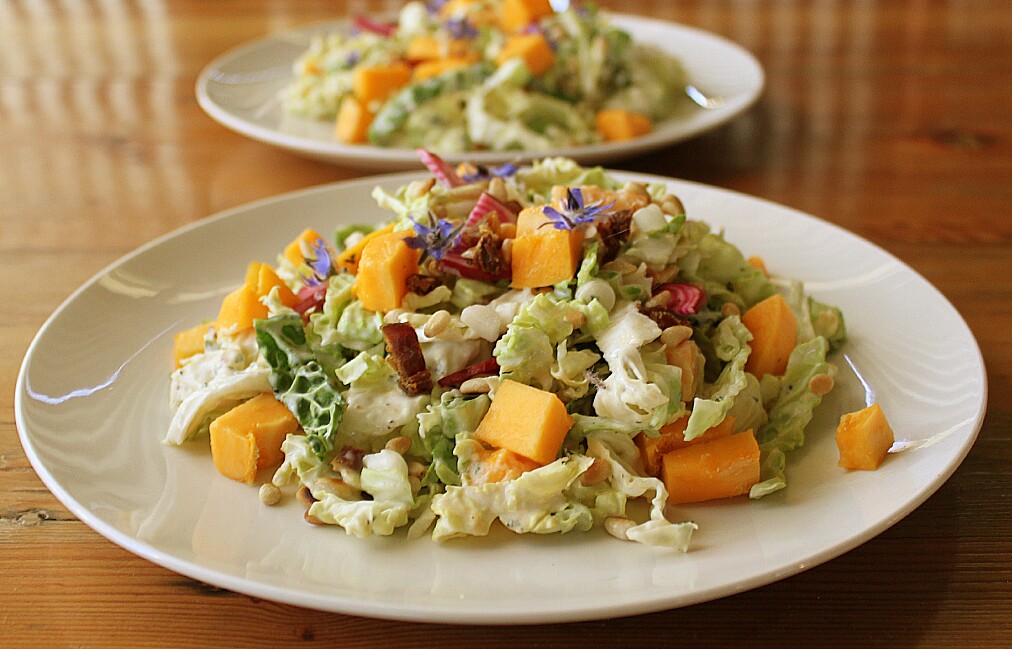At last it’s papaya season. Soft, succulent, coral papaya to feast on for at least two months … that’s if Zazu’s bigger-beaked, insatiable cousins, the Trumpeter Hornbills, don’t beat us to it. They fly in at dawn and dusk, a silent squadron of sometimes 50 bombers. They land and perch camouflaged in low branches of the trees in our vegetable garden, their crinkly scarlet-rimmed eyes focused only on the rich pickings before them: the bursting orange skin of ripe papaya. They desire nothing else in the garden, just the papaya.

It’s only when one of them can’t restrain the glee of its gorging, and cries out like a human baby, do we cotton on to the invasion. Lobbing small stones from a designated pile near the house, shouting obscenities in Tockus–talk, we chase them from the papaya into the indigenous trees on the outer perimeter of the garden. And there they wait. Nose in the air, feigning boredom. The hornbills surrender only when they see that we’re watching for them, poised with our stones. Then they take flight together, crying as they leave, a gang of thwarted freeloaders.

I’m inspired by the high flavors and tastes of North African food, with its mix of African, European and Arabic influences. The use of fresh, wholesome ingredients–assorted vegetables, mint, coriander, papaya, mangoes, lemons, sweet nuts, dates and figs–uplifted by striking combinations, really suits the way we eat here on the farm.
I picked our first savoy cabbage over the weekend and wanted to use it in combination with a ripened papaya, so decided to create a North African-inspired coleslaw for a late Sunday lunch. I combined these two ingredients with the last of our sweet stripey beetroot, a small bunch of spring onions, and fresh mint … all from the garden. I added chopped dates, roasted pine nuts and roasted caraway seeds, and then pulled it altogether with a yogurt, lemon juice and tahini dressing.
The recipe is below, but I recommend you experiment with the quantities of each ingredient for the coleslaw and its dressing, depending on what you prefer. These flavors are distinct and some are strong. Just remember to try not to overpower one with another. It’s all about balance! This recipe would be a perfect accompaniment to a variety of slow-cooked meat dishes, such as a tagine, as well as couscous or quinoa.

North African-Inspired Coleslaw
Ingredients:
Coleslaw
- 1 small savoy cabbage head, halved and finely sliced
- 1 ripe papaya, cut neatly into cubes
- 2 small beetroot, finely sliced
- 1/4 cup spring onions, finely sliced
- 5 dates, pitted and finely chopped
- 1/4 cup pine nuts, dry-roasted
- 2 tablespoons caraway seeds, dry-roasted
- 1 tablespoon mint, finely chopped
- Salt and pepper to taste
- 10 fresh borage flowers for garnish
Dressing
- 1/2 cup plain yogurt
- 3 tablespoons tahini
- 3 tablespoons fresh lemon juice
- 1 tablespoon mint, finely chopped
- 1 small clove garlic, minced
- Salt & pepper to taste
Method:
1. Combine all the ingredients for the coleslaw in a large mixing bowl, saving a small quantity of each to use as garnish before serving.
2. Combine all the ingredients for the dressing in a smaller bowl, making sure they are mixed together well.
3. Carefully combine the yogurt and tahini dressing with the mixture of salad ingredients, making sure that the ingredients are evenly spread.
4. Garnish and serve immediately.
Yield: 2-4 depending on whether it’s eaten as a side or main dish.


